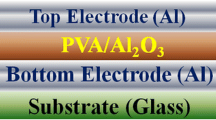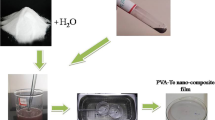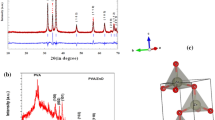Abstract
Thin films of polyvinyl alcohol (PVA)–aluminium oxide(Al\(_2\mathrm{O}_3\)) composite have been made by solution casting method. XRD, FESEM and FTIR techniques were used to characterize the prepared composite films for structural analysis. The existence of M–O bond was identified by FTIR. XRD study reveals that PVA composite has polycrystalline in nature. The morphological study shows the dispersion of Al\(_2\mathrm{O}_3\) particles on the surface of thin films. The effect of temperature and frequency on dielectric properties of PVA–Al\(_2\mathrm{O}_3\) composite was investigated and improvement of dielectric properties with temperature observed. AC conductivity is increased with temperature and maximum conductivity of \(3.20 \times 10^{-5}\) S/cm for PVAl-10% at 353 K is observed. Activation energy is evaluated from Arrhenius plot and found to lie in between 0.05 and 0.16 eV. Frequency exponent factor ‘s’ for Pristine PVA and PVAl-10% was calculated and found to lie in between 0 and 1. Impedance plots depict the semicircle at higher frequencies and residual tail at the lower frequencies and value of Rb is found to decrease till PVAl-10% and increased for further concentration. The prepared PVA–Al\(_2\mathrm{O}_3\) composites could be used in optoelectronic devices and thin film transistors as high k layer due to their high dielectric constant with low dielectric loss.










Similar content being viewed by others
References
Polu AR, Kumar R (2011) Ac impedance and dielectric spectroscopic studies of Mg2+ ion conducting PVA-PEG blended polymer electrolytes. Bull Mater Sci 34(5):1063–1067
Nigrawal A, Chand N (2013) Electrical and dynamic mechanical analysis of nano alumina addition on polyvinyl alcohol (Pva) composites. Prog Nanotechnol Nanomater 2(2):25–33
Patil R, Roy AS, Anilkumar KR, Jadhav KM, Ekhelikar S (2012) Dielectric relaxation and ac conductivity of polyaniline-zinc ferrite composite. Compos Part B Eng 43(8):3406–3411
Polu AR, Kumar R, Kumar KV (2012) Ionic conductivity and electrochemical cell studies of new Mg2+ ion conducting PVA/PEG based polymer blend electrolytes. Adv Mater Lett 3:406–409
Aziz SB, Abidin ZHZ (2015) Ion-transport study in nanocomposite solid polymer electrolytes based on chitosan: electrical and dielectric analysis. J Appl Polym Sci 132(15):41774-1–41774-10
Aziz SB (2016) Role of dielectric constant on ion transport: reformulated Arrhenius equation. Adv Mater Sci Eng 2013. doi:10.1155/2016/2527013
Salleh NS, Aziz SB, Aspanut Z, Kadir MFZ (2016) Electrical impedance and conduction mechanism analysis of biopolymer electrolytes based on methyl cellulose doped with ammonium iodide. Ionics 22(11):2157–2167
Sugumaran S, Bellan CS, Nadimuthu M (2015) Characterization of composite PVA-Al2O3 thin films prepared by dip coating method. Iran Polym J 24(1):63–74
Sugumaran S, Bellan CS, Muthu D, Raja S, Bheeman D, Rajamani R (2015) New transparent PVA-InTiO hybrid thin films: influence of InTiO on the structure, morphology, optical, and dielectric properties. Polym Adv Technol 26(12):1486–1493
Chand N, Rai N, Natarajan TS, Agrawal SL (2011) Fabrication and characterization of nano Al2O3 filled PVA: Nh4scn electrolyte nanofibers by electrospinning. Fibers Polym 12(4):438–443
Tuncer E, Duckworth RC, Sauers I, James DR, Ellis AR (2007) Dielectric properties of polyvinyl alcohol filled with nanometer size barium titanate particles. In: Electrical insulation and dielectric phenomena, 2007. CEIDP 2007. Annual Report-Conference. IEEE, pp 225–227
Joge P, Kanchan DK, Sharma P, Gondaliya N (2013) Effect of nano-filler on electrical properties of PVA-PEO blend polymer electrolyte. Indian J Pure Appl Phys 51(5):350–353
Prajapati GK, Gupta PN (2011) Comparative study of the electrical and dielectric properties of PVA-PEG-Al2O3-MI (M= Na, K, Ag) complex polymer electrolytes. Phys B Condens Matter 406(15):3108–3113
Mallakpour S, Dinari M (2013) Enhancement in thermal properties of poly (vinyl alcohol) nanocomposites reinforced with Al2O3 nanoparticles. J Reinf Plast Compos 32(4):217–224
Hussien B (2011) The DC and AC electrical properties of (PMMA-Al2O3) composites. Eur J Sci Res 52:236–242
Makled MH, Sheha E, Shanap TS, El-Mansy MK (2013) Electrical conduction and dielectric relaxation in p-type PVA/CUI polymer composite. J Adv Res 4(6):531–538
Rathod SG, Bhajantri RF, Ravindrachary V, Pujari PK, Sheela T (2014) Ionic conductivity and dielectric studies of LiClO 4 doped poly (vinylalcohol)(PVA)/chitosan (CS) composites. J Adv Dielectr 4(04):1450033
Senthil V, Badapanda T, Chithambararaj A, Bose CA, Mohapatra AK, Panigrahi S (2012) Dielectric relaxation behavior and electrical conduction mechanism in polymer-ceramic composites based on sr modified barium zirconium titanate ceramic. J Polym Res 19(7):9898
Thakur VK, Lin M-F, Tan EJ, Lee PS (2012) Green aqueous modification of fluoropolymers for energy storage applications. J Mater Chem 22(13):5951–5959
Thakur VK, Tan EJ, Lin M-F, Lee PS (2011) Poly (vinylidene fluoride)-graft-poly (2-hydroxyethyl methacrylate): a novel material for high energy density capacitors. J Mater Chem 21(11):3751–3759
Thakur VK, Gupta RK (2016) Recent progress on ferroelectric polymer-based nanocomposites for high energy density capacitors: synthesis, dielectric properties, and future aspects. Chem Rev 116(7):4260–4317
Lin M-F, Thakur VK, Tan EJ, Lee PS (2011) Dopant induced hollow BaTiO 3 nanostructures for application in high performance capacitors. J Mater Chem 21(41):16500–16504
Wu GM, Lin SJ, Yang CC (2006) Preparation and characterization of pva/paa membranes for solid polymer electrolytes. J Membr Sci 275(1):127–133
Guirguis OW, Moselhey MTH (2012) Thermal and structural studies of poly(vinyl alcohol) and hydroxypropyl cellulose blends. Nat Sci 4(1):57–67
Sangawar VS, Moharil NA (2012) Study of electrical, thermal and optical behavior of polypyrrole filled PVC: PMMA thin film thermoelectrets. Chem Sci Trans 1(2):447–455
Shuhaimi NEA, Teo LP, Woo HJ, Majid SR, Arof AK (2012) Electrical double-layer capacitors with plasticized polymer electrolyte based on methyl cellulose. Polym Bull 69(7):807–826
Mohamed SA, Al-Ghamdi AA, Sharma GD, El Mansy MK (2014) Effect of ethylene carbonate as a plasticizer on CuI/PVA nanocomposite: structure, optical and electrical properties. J Adv Res 5(1):79–86
Shekar BC, Sathish S, Sathyamoorthy R (2011) Morphology, structure and conduction properties of PVA nano scale films for field effect organic thin film transistor applications. Int J Nanotechnol Appl 5:297–308
Aziz SB (2016) Modifying poly (vinyl alcohol)(PVA) from insulator to small-bandgap polymer: a novel approach for organic solar cells and optoelectronic devices. J Electron Mater 45(1):736–745
Ghanipour M, Dorranian D (2013) Effect of ag-nanoparticles doped in polyvinyl alcohol on the structural and optical properties of PVA films. J Nanomater 2013:2
Labidi NS, Djebaili A et al (2008) Studies of the mechanism of polyvinyl alcohol adsorption on the calcite/water interface in the presence of sodium oleate. J Miner Mater Charact Eng 7(02):147
Gurunathan K, Amalnerkar DP, Trivedi DC (2003) Synthesis and characterization of conducting polymer composite (PAn/TiO 2) for cathode material in rechargeable battery. Matérials Letters 57(9):1642–1648
Amin GAM, Abd-El Salam MH (2014) Optical, dielectric and electrical properties of PVA doped with Sn nanoparticles. Mater Res Express 1(2):025024
Aziz SB, Abidin ZHZ, Arof AK (2010) Influence of silver ion reduction on electrical modulus parameters of solid polymer electrolyte based on chitosan-silver triflate electrolyte membrane. Express Polym Lett 5:300–310
Lin H-W, Hwu W-H, Ger M-D (2008) The dispersion of silver nanoparticles with physical dispersal procedures. J Mater Process Technol 206(1):56–61
Aziz SB, Abidin ZHZ (2013) Electrical conduction mechanism in solid polymer electrolytes: new concepts to Arrhenius equation. J Soft Matter. doi:10.1155/2013/323868
Aziz SB (2013) Li+ ion conduction mechanism in poly (\(\varepsilon\)-caprolactone)-based polymer electrolyte. Iran Polym J 22(12):877–883
Liang Y-H, Wang C-C, Chen C-Y (2008) Synthesis and characterization of a new network polymer electrolyte containing polyether in the main chains and side chains. Eur Polym J 44(7):2376–2384
Fonseca CP (2007) Cavalcante F Jr, Amaral FA, Zani Souza CA, Neves S (2007) Thermal and conduction properties of a PCL-biodegradable gel polymer electrolyte with LiClO4, LiF3CSO3, and LiBF4 salts. Int J Electrochem Sci 2(1):52–63
Eliasson H, Albinsson I, Mellander B-E (2000) Conductivity and dielectric properties of AgCF 3 SO 3-PPG. Mater Res Bull 35(7):1053–1065
Ramya CS, Selvasekarapandian S, Hirankumar G, Savitha T, Angelo PC (2008) Investigation on dielectric relaxations of PVP-NH 4 SCN polymer electrolyte. J Non Cryst Solids 354(14):1494–1502
Rathod SG, Bhajantri RF, Ravindrachary V, Sheela T, Pujari PK, Naik J, Poojary B (2015) Pressure sensitive dielectric properties of TiO2 doped PVA/CN-Li nanocomposite. J Polym Res 22(2):1–14
Yadav VS, Sahu DK, Singh Y, Dhubkarya DC (2010) The effect of frequency and temperature on dielectric properties of pure poly vinylidene fluoride (PVDF) thin films. In: Proceeding of the international multi-conference of engineer and computer scientists, vol 3. Citeseer
Roy M, Nelson JK, MacCrone RK, Schadler LS, Reed CW, Keefe R (2005) Polymer nanocomposite dielectrics-the role of the interface. IEEE Trans Dielectr Electr Insul 12(4):629–643
Kamath A, Devendrappa H (2015) Concentration-dependent ionic conductivity and dielectric relaxation of methyl blue-dyed polyethylene oxide films. Polym Bull 72(10):2705–2724
Tsangaris GM, Psarras GC, Kouloumbi N (1998) Electric modulus and interfacial polarization in composite polymeric systems. J Mater Sci 33(8):2027–2037
Aziz SB (2015) Study of electrical percolation phenomenon from the dielectric and electric modulus analysis. Bull Mater Sci 38(6):1597–1602
Ahmad F, Sheha E (2013) Preparation and physical properties of (PVA) 0.7 (NaBr) 0.3 (H3PO4) x M solid acid membrane for phosphoric acid-fuel cells. J Adv Res 4(2):155–161
MacCallum JR, Tomlin AS, Vincent CA (1986) An investigation of the conducting species in polymer electrolytes. Eur Polym J 22(10):787–791
Aziz SB (2016) Occurrence of electrical percolation threshold and observation of phase transition in chitosan (1-x) x. Appl Phys A 122(7):1–13
Yusof YM, Illias HA, Kadir MFZ (2014) Incorporation of NH4Br in PVA-chitosan blend-based polymer electrolyte and its effect on the conductivity and other electrical properties. Ionics 20(9):1235–1245
Author information
Authors and Affiliations
Corresponding author
Rights and permissions
About this article
Cite this article
More, S., Dhokne, R. & Moharil, S. Structural properties and temperature dependence dielectric properties of PVA-Al\(_2\mathrm{O}_3\) composite thin films. Polym. Bull. 75, 909–923 (2018). https://doi.org/10.1007/s00289-017-2069-0
Received:
Revised:
Accepted:
Published:
Issue Date:
DOI: https://doi.org/10.1007/s00289-017-2069-0




